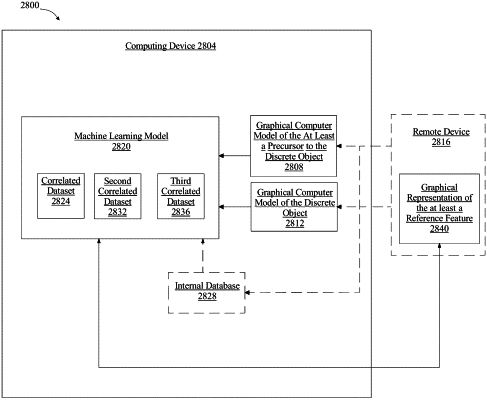| CPC G05B 19/4155 (2013.01) [B33Y 30/00 (2014.12); B33Y 50/02 (2014.12); G06N 20/00 (2019.01); G05B 2219/31368 (2013.01); G06F 30/10 (2020.01); G06F 2113/10 (2020.01)] | 18 Claims |

|
1. An automated manufacturing system for generating a graphical representation of a discrete object to be manufactured from an additively manufactured body of material, including a precursor to a discrete object and at least a reference feature, at a computing device, the automated manufacturing system is designed and configured to:
receive a graphical computer model of the at least a precursor to the discrete object and a graphical computer model of the discrete object;
identify at least a first feature in the graphical computer model of the discrete object, and recommended joining data;
selecting a correlated dataset containing a plurality of data entries wherein each dataset contains a geometric description of at least a stored critical-to-quality shape description and a correlated shape that requires manufacture to the first tolerance;
training a machine-learning model with the correlated dataset; and
automatedly determine, at the machine-learning model, that the at least a first feature includes at least a critical-to-quality feature in the graphical computer model of the discrete object, wherein automatedly determining at the machine-learning model comprises:
determining, at the machine-learning model, the geometric description of the at least a surface feature matches the geometric description of the correlated dataset as a function of comparing the geometric description of the at least a surface feature to the correlated dataset, wherein the machine-learning model is trained by the correlated dataset;
automatedly generate, at the machine-learning model, a graphical representation of the at least a reference feature on the graphical model of the at least a precursor to the discrete object as a function of the at least a critical-to-quality feature, at least a locating feature in a support, and the recommended joining data, wherein the at least a critical-to-quality feature corresponds to a shape that requires manufacture to a first tolerance based on the correlated dataset, and wherein the support comprises a substrate for deposition of layers in an additive process; and
automatedly determine a second feature as a non-critical to quality feature to be manufactured to a second tolerance which is lower than the first tolerance, wherein the non-critical to quality feature comprises surface finish or fit.
|